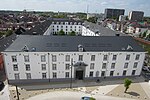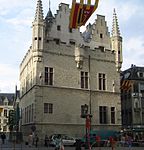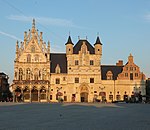Oscar Vankesbeeck Stadion
1923 establishments in BelgiumBelgian sports venue stubsBuildings and structures in MechelenFootball venues in FlandersK.R.C. Mechelen ... and 2 more
Sports venues completed in 1923Sports venues in Antwerp Province
The Oscar Vankesbeesckstadion is a football stadium, located in Mechelen, Belgium, and is host to K.R.C. Mechelen. With a capacity of 6,123.The stadium, located Oscar Vankesbeeckstraat, is named after Oscar Van Kesbeeck, a Flemish politician, who was chairman of the Belgian Football Association between 1937 and 1943, and a former chairman and player of Racing Mechelen. It is located about 1.5 kilometers far from the Veolia Stadium of rivals KV Mechelen.
Excerpt from the Wikipedia article Oscar Vankesbeeck Stadion (License: CC BY-SA 3.0, Authors).Oscar Vankesbeeck Stadion
Elektriciteitstraat, Mechelen
Geographical coordinates (GPS) Address External links Nearby Places Show on map
Geographical coordinates (GPS)
| Latitude | Longitude |
|---|---|
| N 51.037777777778 ° | E 4.4716666666667 ° |
Address
Oscar Vankesbeeckstadion
Elektriciteitstraat
2800 Mechelen (Mechelen)
Antwerp, Belgium
Open on Google Maps








